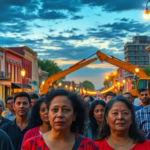DHS Issues Waiver for 17 Miles of Water Barriers in Cameron County
The Rio Grande Valley (RGV) is poised for significant changes following a recent announcement by the Department of Homeland Security (DHS). On Thursday, DHS Secretary Kristi Noem authorized a waiver to expedite the construction of 17 miles of waterborne barriers in Cameron County. This decision is part of a broader strategy to address and close gaps in border security, specifically aiming to deter illegal activities such as drug smuggling and human trafficking in the region.
Understanding the Waiver and Its Implications
The waiver allows for the circumvention of the National Environmental Policy Act (NEPA), effectively bypassing the extensive environmental reviews that typically precede such projects. While this move speeds up the construction process, it raises concerns among environmental groups about the potential ecological impact and the loss of public discourse on these sensitive issues.
In a statement released by DHS, the waterborne barriers are described as a critical component in achieving operational control of the Southern border. The statement emphasized the presence of a “capability gap” in the region as a major vulnerability exploited by criminal activities. “By addressing this gap, the construction of waterborne barriers will support our border security objectives and create a safer environment for Border Patrol agents,” the release noted.
Impact on the Rio Grande Valley
The decision to construct water barriers in Cameron County has elicited mixed reactions from Valley residents. On one hand, proponents argue that enhanced border security is necessary for community safety and the reduction of illegal cross-border activities. Local officials have expressed optimism, viewing the barriers as an innovative solution to longstanding security concerns. Ricardo Gomez, a member of the Cameron County Commissioners Court, stated, “Security measures like these are vital for safeguarding our community and ensuring a safe environment for all residents.”
Conversely, environmental advocates and some community members have voiced apprehensions regarding the waiver. Rachel Martinez, a local environmental activist, expressed her concerns: “By bypassing environmental assessments, we risk damaging our ecosystem irreparably. We owe it to future generations to protect our natural resources while maintaining security.”
Contextual Background and Related Issues
The issue of border security in South Texas has long been a topic of discussion and debate. Previously, the construction of land-based barriers has often met with resistance due to concerns over land use, the impact on wildlife corridors, and the rights of landowners. The shift towards waterborne barriers represents a new chapter in this ongoing narrative.
Furthermore, as the region prepares for holiday festivities and events like the Stars and Stripes Freedom Festival in Weslaco, local authorities are emphasizing public safety. The increased security presence on the water during this period reflects broader law enforcement efforts to maintain order and reduce crime.
Looking Ahead: Potential Outcomes and Future Plans
While a timeline for the barrier’s construction remains undisclosed, the project’s progression will be closely watched by stakeholders across the RGV. In terms of future implications, successful implementation of the water barriers may pave the way for similar projects along other parts of the Southern border. It could also set a precedent for how security enhancements are balanced with environmental and community considerations.
Moreover, ongoing dialogues between federal, state, and local bodies will be crucial in ensuring that multiple perspectives are considered, particularly those of Valley residents who are directly affected by these initiatives.
Engaging the Community
In light of the potential impacts on the community, DHS and local officials are encouraged to facilitate forums and open dialogues to keep residents informed and engaged. Public input can play a pivotal role in addressing valid concerns and fostering a sense of mutual understanding and cooperation.
For community members seeking to stay informed or voice concerns, resources such as the DHS website, local town halls, and contact lines will be integral in bridging communication gaps and ensuring transparency throughout the project’s lifecycle.
Conclusion
The authorization of a waterborne barrier in Cameron County represents a significant development in border security for the RGV. This measure highlights the complex interplay between enhancing safety, protecting the environment, and respecting community interests. As this project unfolds, it underscores the need for balanced, informed, and community-centered approaches in addressing the multifaceted challenges faced by the Valley and similar regions nationwide.







